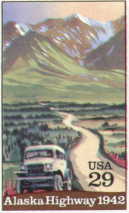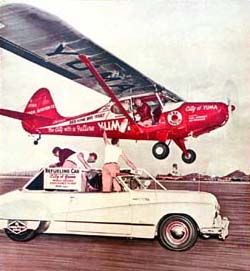
Home
Aviation Stories
"In Memory Of"
Net Sites
Sign Guestbook
View Guestbook
Email Ron
Sell your Trust Deed

"City of Yuma" World Endurance Record Re-enactment FlightYuma, Arizona treasure flies after a 50-year nap and 1949 world endurance record.
Story by Ron Kilber

As was the case all over the country after World War II, military communities such as Yuma, Arizona, lost their vitality when the military closed a facility no longer needed when the war ended. Yuma, for example, began losing its population rapidly when the military closed its Army Air Corps Training School, which was used to train combat pilots and crews. By the time the initial class of cadets arrived in 1943, millions of dollars had already been spent on construction for infrastructure to support the airfield and new base. The training facility was destined to become one of the largest in the country, attributed in no small way to Yuma's 365 annual flying days. Government dollars continued to pour into Yuma throughout the war, and the resulting growth in population and local business came to depend on the export of new pilots and crew. Yuma was in its heyday.
As with everything in life, all good things eventually end. The war was over, and so were the federal dollars for many communities throughout the country. But in Yuma's case, the slump didn't last for long. Thanks in no small way to a couple of enterprising ex-Navy fliers, together with several backers and hundreds of volunteers, who devised a clever stunt, which not only put Yuma back on the map, but in the money, too.
In October, 1949, their "City of Yuma" (N1156H, an Aeronca Sedan, AC-15, 145-hp Continental engine) went on to set the world endurance record -- more than 46 days aloft! The distance traveled was equivalent to circumnavigating the world roughly every thirteen days. No one ever in all of human history stayed aloft longer. Not only did the feat pique the interest of powers-that-were in Washington, D.C., about Yuma's perpetually clear skies and excellent flying weather, but the Air Force reopened its base within two years. And those government dollars, which once flowed generously during WWII, had begun to flow again. Not a single person in the City of Yuma all-volunteer effort profited individually, but prosperous times for everyone had returned to Yuma.
The "City of Yuma" today
After N1156H napped for half a century from its record-setting duty -- spanning some 18 owners -- the "City of Yuma" today has been restored to its near-1949 condition. Its resurrectors recovered the aviation relic in 1997 from a farm in Minnesota. In fact, N1156H had only accumulated about as many airframe hours during the last 50 years as had been accumulated during 1949 in preparation for and during the endurance flight.
On October 10, 1999 (exactly 50 years to the day), the "City of Yuma" was ready to officially fly again, re-enacting the incredible world endurance record set back in 1949, complete with a freshly restored 1948 Buick Super convertible serving as the refueling car. Just as in 1949, local residents, visitors and reporters arrived to witness the festivities and re-enactment of the City of Yuma refueling exercise. Even Woody Jongeward and Bob Woodhouse (then age 31 and 26), the "City of Yuma" original pilots, were on hand to share in the event.
When asked if he would do it again, Woody Jongeward responded, "No! Once is enough."
Bob Woodhouse actually piloted the City of Yuma during one of the recent test flights. When asked how the airplane compares now, Bob responded, "I don't remember; that was fifty years ago."
How Jongeward and Woodhouse did it in 1949
Staying aloft forty-six days in any airplane is no small feat -- even today. Imagine having done so fifty years ago. With sheer grit, perseverance and the help of hundreds of others who assisted, Jongeward and Woodhouse managed to pull off their incredible world endurance record. It was not without challenges.
For one, they needed a perpetual supply of fuel if they were to remain airborne without ever landing. So, whenever they needed their tanks topped, they flew the "City of Yuma" low and slow along side a 1948 Buick convertible where, à la the bucket brigade, the ground crew handed up fuel to the copilot. The gas was poured into extra tanks (the right and back seats had been removed), then pumped by hand when needed to the 36-gallon capacity in the wings. The team refueled the airplane, first twice, then three times daily, handing up fuel in 2.5-gallon containers to satisfy the more than 156-gallon daily demand and 7,300-plus gallons required for the entire feat. All together, about 3,000 containers-full of fuel were passed up to the off-duty pilot. The total fuel, perhaps, was equivalent to twenty times the gross weight of the "City of Yuma".
Also required was a constant supply-line of food, clothing, toiletries and oil, even parts and tools when needed -- again, à la the bucket brigade. The engine lubricating system was modified to accommodate airborne oil changes every one-hundred hours (4 days). A specially installed sight gauge indicated when the engine required more oil, which was consumed at a rate of 7/16 of a pint an hour -- about 250 quarts all told.
Sleeping was another problem. Flying in four-hour shifts enabled the off-duty pilot to sleep, eat, groom and change clothes, among other things such as pulling bucket duty. The cycle repeated for each pilot every eight hours three times daily. Their spirits always high, the men forged on hour-after-hour, day-upon-day until they would reach "Ten Ten": 1010 hours. That was the magic number they chose to beat the previous endurance record of 1,008 hours set by Bill Barris and Dick Riedel only months earlier flying "The Sunkist Lady" out of Fullerton, California.
As their flight pressed on, word of the event spread gradually, first to other cities, then other states and finally the world. Press organizations around the globe reported on the event daily. Nationally syndicated radio programs included patch-through conversations with the pilots, and were then broadcasted around the world nightly. Sitting presidents, then or now, couldn't sustain the degree of press interest that Jongeward and Woodhouse commanded in 1949. For them in 1949, their accomplishment was comparable to Neal Armstrong when he first set foot on the moon twenty years later. The spotlight Jongeward and Woodhouse created most assuredly helped both pilots press on -- all the way to the end. It came on October 10, 1949 after accumulating more than 1,124 hours aloft. They exceeded their "Ten Ten" goal, which, coincidentally, exactly represented the day they landed the "City of Yuma" -- 10/10/1949. No one could have predicted, much less plan, that it turned out that way. Their record would not be broken for ten more years in Las Vegas, Nevada.
How they did it today
Throughout the years since 1949, the "City of Yuma" had been kept alive in the hearts and minds of many Yumans. There was always talk among residents and pilots wondering what had become of their City of Yuma. Eventually, curiosity rose to action, and by 1997 the Yuma Jaycee Foundation had taken an interest in not only recovering their treasure, but funding its purchase and restoring it to the glory days of the endurance flight. Eventually, the recovery team identified and located N1156H's owner, and then dispatched two men to the Minnesota farm to retrieve the "City of Yuma" once and for all.
I had the privilege to fly N1156H after the "City of Yuma" had been restored and made airworthy again. My opportunity came in conjunction with the air-to-air photography required for this story. What a grand experience it was to fly the airplane made famous by Jongeward and Woodhouse 50 years earlier. Our flight lasted more than an hour as we first flew over the Shilo Inn and Resort (where I stayed to do this story -- and a great place to stay when visiting Yuma), then over the historic Yuma Territorial Prison, and finally towards the U.S.-Mexican border where we traversed in and around the miles and miles of the white sand dunes of California. Most assuredly, Jongeward and Woodhouse flew these same sand dunes hundreds of times during their '49 conquest. Those same sand dunes, which would be used later to film one of the most memorable aviation movies of all times -- "The Flight of the Phoenix". In no small way, I couldn't help realizing that not only did the "Phoenix" rise from its ashes, but so, too, has the "City of Yuma". What a glorious time for everyone who was involved then and has been now.
I tried to imagine what it must have been like for the pioneer pilots to have remained aloft for 46 days in the very airplane I flew. I also wondered, had I been around and old enough at the time, if I would've stepped forward to pilot the "City of Yuma" on its endurance flight. "Yes", I concluded. And even with a similar opportunity presenting itself now, I'd be the first to volunteer -- in a heartbeat.
The "City of Yuma" looses engine power
When it was time to end the flight, we bee-lined from the sand dunes of California straight for the airport in Yuma. Within only miles from the airport, the engine began to lose power. First, rpms dropped, then increased; then the cycle repeated over and over. Nothing remedied the situation. Too low and too far out to make the runway, I was fully prepared to set down in what may well have been a cantaloupe field on the outskirts of Yuma. But by the grace of God, somehow, the engine regained full and steady power. Without further incidence, we landed safely and taxied to Bet-Ko Aviation, the temporary home and one of the sponsors for the "City of Yuma".
Later I learned that the engine problem was caused by fuel starvation from the left wing tank. Happily, the problem was found and corrected just in time for the "City of Yuma" World Endurance Record Re-enactment Flight -- without any incidence.
The future for the "City of Yuma"
To commemorate the endurance flight and preserve the "City of Yuma" for generations to come, The Yuma Jaycee Foundation, the owner, is making plans to put the airplane on display in a museum environment where it will always be available for anyone in the public to examine and study.
For the world to view, the "City of Yuma" has its own home on the Internet (see link below), complete with restoration records and media references dating to 1949.
Also, the Mayor and Yuma have submitted the "City of Yuma" endurance restoration project to the White House Millennium Council for recognition in the "Millennium Communities" program: "Honor the past -- imagine the future". The mission of the Council is to lead the country in a celebration of the new millennium by initiating and recognizing national and local projects that contribute in educational, creative, and productive ways to America's commemoration of this historic time.
http://www.millenniumcommunities.org
Contact InformationJaycee Foundation
PO Box 121
Yuma, Arizona 85366-0121
Phone: (520) 344-3860
Fax: (520) 317-0705
jspencer@primenet.com
http://aztec.asu.edu/enduro49
Ron Kilber (rpknet@aztec.asu.edu) is a private pilot and flying enthusiast living in Arizona. He is a director of the Dakota Squadron, a WWII Aviation History Museum in The Netherlands. His work and fascinating adventure stories have appeared in many aviation publications.
###
Copyright (C) 1999 Ron Kilber rpknet@aztec.asu.edu RonKilber.tripod.com You may reprint this story for non-commercial use provided this copyright notice is left intact. Permission will not be unreasonably withheld for all other uses.